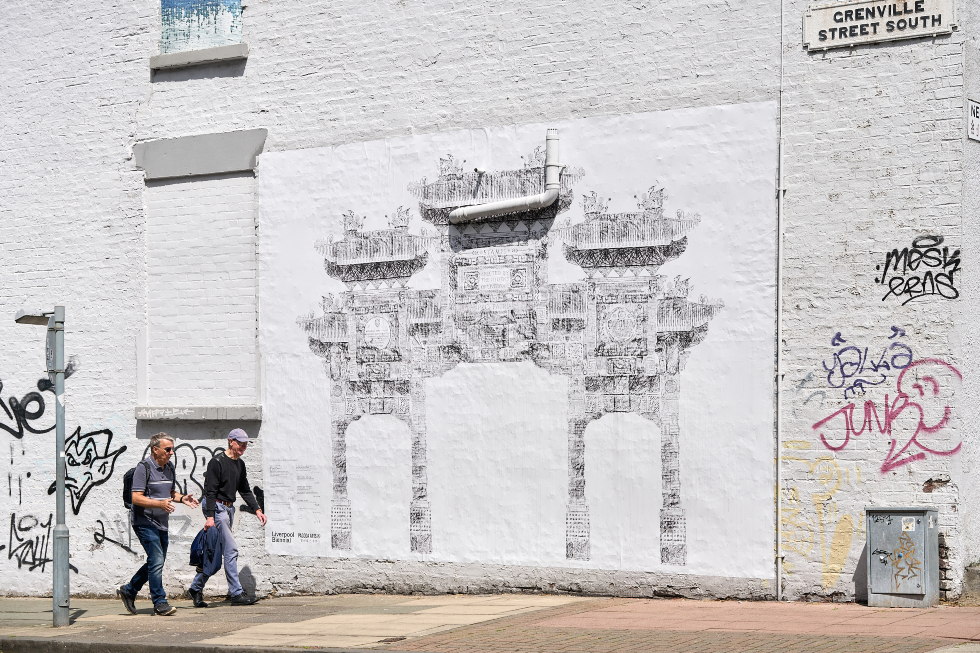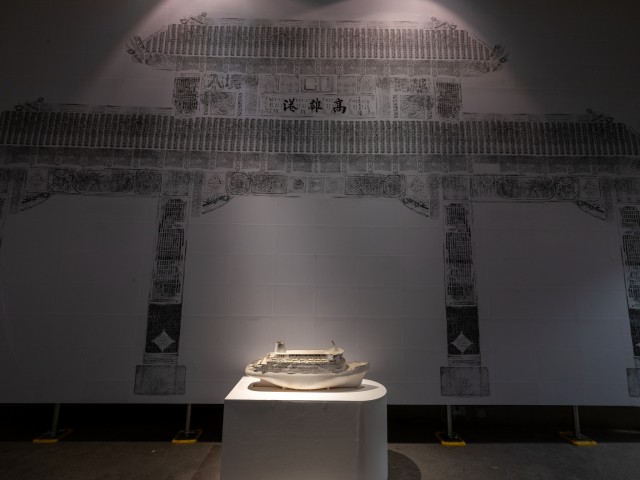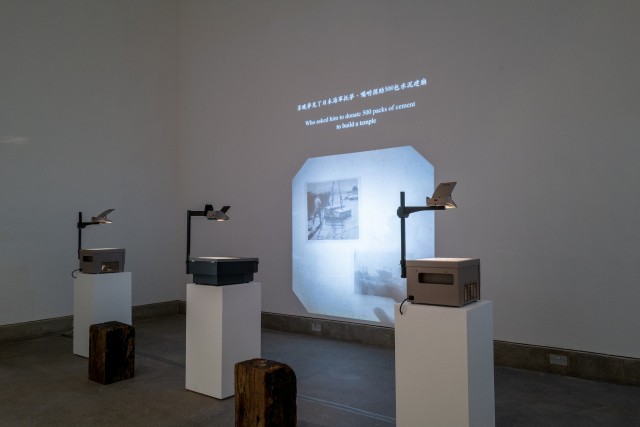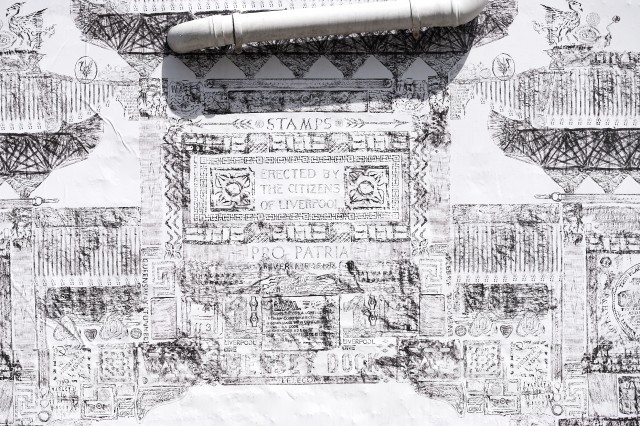Setting Forth on a Voyage of Discovery with ChihChung Chang 張致中

“Exploring the work of ChihChung Chang is to better understand the slippage between stories we think we know and those as experienced by living, breathing places – and the communities calling them home.” Mike Pinnington digs into the artist and cultural researcher’s multi-site contribution to Liverpool Biennial 2025…
On the site of a former Chinese boarding house in Liverpool’s Great George Square there is a blue plaque commemorating the contribution to the city’s history by Chinese seafarers forcibly deported from the city in 1946. A shameful, underexposed chapter in the UK’s post-Second World War history, the policy separated thousands of seafarers from their families. That its unveiling, coming in July 2024, is so recent speaks to the complex, disproportionate relationship between Britain, this city, and the oldest Chinese community in Europe.
As if to reflect this complexity, there are many strands to Taiwanese artist and cultural researcher ChihChung Chang’s multi-site Liverpool Biennial contribution. To engage with the fruits of Chang’s research is not unlike prying off the thin though stubborn façade of place to get to the real, human stories beneath; at other times, it is more akin to setting forth on a voyage of discovery. Exploring the work of this cultural cartographer is to better understand the slippage between stories we think we know and those as experienced by living, breathing places – and the communities calling them home.
Across a satisfying multi-disciplinary installation at city centre venue, Bluecoat, an outside companion piece situated in Liverpool’s China Town, and a film in the nearby Pine Court Housing Association, the works speak to interwoven threads, allusions and tensions to unpick, consider and address. They each tell a part of the story in and of themselves, but – as with much of this Biennial – it is best to think of them as constituent parts. To experience each complementary aspect as parts of a whole is to see Chang’s research coalesce into a bigger picture.

At Bluecoat, you’ll find narratives of social history that reference family, community, biography, industrial decline, and cultural regeneration via post-modernity. In a Taiwan-set film of cultural histories told in three chapters, various objects relating to shipping (with a model vessel playing the role of anchor work) and a Chinese Arch come together to form Port of Fata Morgana. It situates art as both tribute – to home and family – and a self-portrait of sorts. This is the stuff of the artist’s life – the place, upbringing and people that have influenced him, one way or another, and inspired the research that lead him here.
Pushing beyond those initial, substantial layers, Port of Fata Morgana (named for the mutable, inconsistent nature of once bustling port cities) instigates a process of identifying and interrogating the commonalities and differences shared by communities separated by language, history and thousands of miles (6,199 if we’re counting). Here, Chang bridges historical, cultural and geographic gaps, by putting his home of Kaohsiung in southern Taiwan in conversation with Liverpool, his artworks’ temporary home.

A multitude of resonances have surfaced in the process. Both Kaohsiung and Liverpool are declining port cities, whose busiest, most profitable shipping days are behind them; they have each been rejuvenated of late, through necessity, by a belief in and commitment to culture as a driving force. These resonances initiate a departure point from which we can dig deeper, and consider the impact on people and places when surroundings and their meaning shifts – planned or otherwise – and vice versa. What does it mean for a place to become a microcosm for a changing world?
A work which gets to the heart of how the warp and weft of place and communities – especially ports – might be felt, is Keystone (2025), a collaboratively made paper mural found in Liverpool’s China Town (on Grenville Street South). Depicting a Chinese Arch, its title responds directly to the BEDROCK theme of Liverpool Biennial; an architectural keystone is structurally crucial. But it might also speak to and acknowledge the strength and diversity within the community it reflects, and the components that make powerful meaning within it.

With facilitation from Liverpool’s Pagoda Arts, whose mission it is ‘to introduce Chinese Culture to a wide and diverse community’, Keystone – artwork as connective tissue – is the manifestation of workshops in which residents were invited to share their stories of and relationships to Liverpool. Sparking these stories, participants were asked to bring along a meaningful object that they felt was important to them and their place in the city, from which they made rubbings in charcoal.
In an accompanying film of these workshops showing at Pine Court, it is clear that its contributors represent a spectrum of ages and backgrounds. Keystone, then, is both representation and in recognition of different generations of people who have helped develop this particular ongoing volume of the story of a city. In it, you can see images of items, text and people’s signatures, along with the artist’s own rubbings. You can pick out Mersey Docks signage; a plaque commemorating David Lewis, department store founder; and Liver Birds standing in for the traditional Chinese dragon – a creature representing power, prosperity and good luck. Taken from across the city, these rubbings link China Town’s communities and heritage to Liverpool at large, as opposed to the limitations of a specific setting.
A cross-section of the culture and society of which they are all part, this isn’t a picture or representation of any one unified story. Nor, I don’t think, is it meant to be. Instead it establishes a place for the many interweaving lives and narratives from the diaspora to be told. Memories, emotions, dreams of the city – these are literal imprints of the community embedded in Liverpool’s urban and psychological landscape.
Rendered in simple monochrome it may be, but Keystone is nothing less than a visualisation of the belonging and adding to that takes place therein, one layer of sediment atop another. It is a living rather than fixed monument, in a way that even the grandeur of the 44ft Imperial Arch that marks the gateway to China Town – a gift from Shanghai to celebrate the twinning of the cities 25 years ago – can’t be.
Mike Pinnington
Liverpool Biennial 2025: BEDROCK continues until 14 September at various venues across the city
Images, from top: ChihChung Chang, ‘Keystone’, 2025. Liverpool Biennial 2025. Photography by Rob Battersby; ChihChung Chang 張致中, ‘Port of Fata Morgana’, 2024. Liverpool Biennial 2025 at Bluecoat. Photography by Mark McNulty; ChihChung Chang, ‘Keystone’, 2025. Liverpool Biennial 2025. Photography by Rob Battersby





